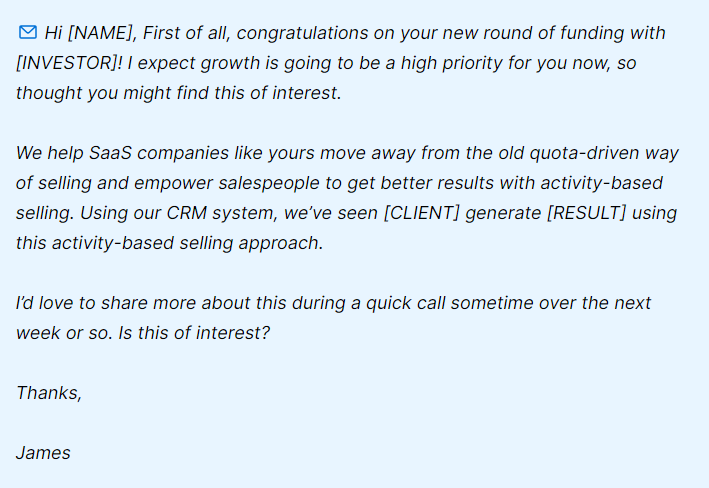The product you’re selling is the best. No, it’s really awesome! Easy to use, innovative, and brimming with great features that your clients love. So you get a new prospect and make a call. You introduce yourself. And (proudly) tell the person on the receiving end what a great opportunity you offer. But they don’t get it. They don’t get it at all.
Oh, the horror.
Well, as salespeople, we can fail to get our message across. Sometimes, it’s inevitable and unfortunate, but it’s not the end of the world. If you often find that you fail to connect with your prospect and make them see the value of the product or service you’re bringing to the table, the reason for that is that your sales pitch needs an upgrade.
In this article, you’ll learn what makes a great sales pitch, what types of sales pitches there are, and get a few examples of top-notch sales pitches you can take inspiration from.
What is a Sales Pitch?
A sales pitch is a brief compelling message that introduces a potential buyer to the product and makes them interested in it. A good sales pitch hooks the buyer’s attention and makes them want to learn more, talk with the sales rep, reply to their email, or schedule a demo. It’s usually crucial for the entire relationship with the prospect—if the pitch falls flat, people are reluctant to give the product a second chance. That’s why it is so important to make your sales pitch engaging and to the point.
The difference between a sales pitch and a full-fledged sales presentation is that it is much shorter, typically under 60 seconds, and it focuses on the buyer’s most important pain point and the core value proposition—no features or details.
However, sales pitches work even better when accompanied by professional-looking sales presentations. Like this one:
Types of Sales Pitches
Reaching out via email is not the same as making a cold call or answering someone’s “So what do you do?” in-person question at an expo. You need to adapt your sales pitch to each of these situations. Here are the types of sales pitches you may need:
- Elevator pitch or in-person pitch
- Email pitch
- Phone pitch
- Social media pitch
- Video pitch
#1 Elevator Pitch
Of course, no one gives sales pitches on their way to the client’s office on the top floor of the business center—that stuff is reserved for Hollywood movies. However, it’s a great metaphor which tells you that you have about 30 seconds to get your point across, typically when meeting your prospect face-to-face at a networking event.
Tips for writing a killer elevator pitch:
- The shorter, the better. Put your value proposition in one sentence that answers 3 questions: who you are, what you do, and why the prospect should care.
- Use simple words. You probably don’t know the prospect’s industry or level of expertise, so fancy jargon will only confuse them. Be clear and helpful.
- Write down what you want to say and practice it beforehand. Ask colleagues for feedback to see if your message resonates with them.
Elevator pitch example
This famous elevator pitch by G2 is too good to miss. It incorporates everything we’ve discussed—it’s short, it’s clear, and it’s delivered in a confident, friendly manner. If you’re interested in your client’s feedback, you would want to learn more about these guys!
#2 Email Pitch
When reaching out via email, it’s important to remember that people’s inboxes are bursting with generic “Hey Jake, I’m just checking in…” types of messages. It’s possible to cut through the noise, but to do that you must come prepared.
Tips for sales pitching via email:
- Do your research. Check the recipient’s social media activity, and look for possible connections—are they a parent or a dog-lover? Have you attended the same events? Maybe, you’re following the same industry projects? Anything that will let the person on the other end know that you aren’t a complete stranger.
- Include your value proposition in the subject line—your prospect should be curious about your offer right off the bat, or they simply won’t open the email. Here are some great suggestions on subject lines for your email pitch.
- Back up your claims. No matter how good your offer is, you need to prove it. The best way to do this is by referring to a happy customer from your prospect’s industry. Call center CRM systems can also be a helpful tool here, as they can provide you with customer data and insights that can be used to craft more persuasive pitches.
- Keep it short and sweet. A personal reference, a value proposition, and a simple explanation of why it works are enough. You can leave all the details and specifics for later when your prospect is already invested in the communication.
- Include a specific call-to-action—ask to schedule a meeting or a call, so the person knows what to do next.
- Send a personalized and interactive sales deck along with your sales pitch. It will immediately set you apart from the competition and entice prospects to explore the offer.
- Don’t forget to follow up! Research shows that the first follow-up has a 40% higher open rate compared to the initial email.
Email pitch example
This business pitch example incorporates all the principles we’ve talked about. It shows that the sales rep follows the company’s news, clearly states the value proposition, and demonstrates how it works by referencing a successful case before suggesting a call.

Source: Pipedrive
#3 Phone Pitch
While the phone sales pitch is very close to email and in-person pitches in terms of structure, it has its peculiarities and possible pitfalls. Here are a few things to consider before making a call.
Tips for sales pitching via phone:
- Choose the right time. Phone calls are generally disruptive, so if you don’t want to start on the wrong foot, think about what your prospect’s typical day may look like and pick the time when they are most likely to be free. It doesn’t mean you should call them at 9.00 PM though! Research suggests that the best time to call is before lunch or toward the end of the workday. That depends on the industry though.
- Be transparent. People are wary of strangers, so if you want to be perceived as credible and trustworthy, you may consider mentioning how you got your client’s contact information right from the start. It will help you look more sincere and keep the client on the line longer.
- Be human. It’s true that you need to keep the focus on the goal of the call and state the reason for calling as fast as possible. But the most successful phone conversations happen when the sales specialist manages to build rapport with the client. You can ask them how they are doing and diverge from the script a bit if it helps to connect with the person on the other end of the line. Active listening is also a great way to show the client you care.
Phone call example
Here’s a great business pitch example of a real prospecting call from Sales Insights Lab.
And here’s what’s good about it:
✅ The caller is respectful and mindful of the client’s time.
✅ The value proposition is stated in the first 30 seconds of the call.
✅ The caller involves the client in an active conversation, letting them share their concerns rather than bombarding them with facts and figures.
✅ The caller doesn’t sell over the phone—their goal is to set up a meeting, and that’s what they do.
To increase the effectiveness of your phone pitch, consider using an outbound call center solution that can streamline your calling process and provide valuable insights for better interactions.
#4 Social Media Pitch
Pitching to someone on LinkedIn or any other social media platform can be as effective as it is tricky. On the one hand, LinkedIn is a perfect place to forge business connections and find like-minded people. On the other, spammers have been abusing direct messages there for years, and people have grown intolerant of any kind of unsolicited messaging. So take one wrong step—and you’ll be blocked for good.
To avoid that, personalize your sales pitch.
- Study your prospect’s social media profile for articles, thoughts, and remarks you can contribute to. Use them in your outreach message to strike a chord with that person and engage them in a conversation.
- Feel free to refer to personal details. The ideal scenario is when you can find a common ground that naturally leads up to your offer: a person you both know or a conference you’ve both attended.
- Keep it professional. On social media, it’s easy to start feeling like you know a person even if you have never talked to them. So you may be tempted to start chatting about something personal or completely unrelated to work. But the chances are you’ll push your prospect away rather if you are overfamiliar with them.
Other than that, the same rules apply—stay concise, transparent, and include a clear call-to-action to get the best results.
Social media pitch example

Source: Cognism
#5 Video Pitch
Video pitching is great, as it lets you sneak an in-person experience into a text message. And it’s highly effective, too. A study by Vidyard found that using video for sales outreach has increased response rates for more than 60% of sales reps.
With a video, you can quickly establish rapport with a prospect as they can see you and not just read a dry text. Plus, it’s much more engaging, so you get more time and attention from your prospect and have a much higher chance to convey your point. Here’s what can go into your video sales pitch:
- Personal greeting
- Your product’s key benefits (elevator pitch)
- Customer review
- Industry reports or some surprising statistics that benefit from visual support
Video pitch example
Your video shouldn’t be very complex or heavily edited. These examples from Vidyard nail it with a clear, friendly message from one of their sales reps.
Bonus: Interactive Sales Pitch Deck Example
While an effective pitch is always short and to the point, sometimes it makes sense to share a bit more information about your product, its benefits, and its killer features. And a perfect way to do it is by complementing your message with an attention-grabbing sales pitch deck. Here’s one created with FlippingBook:
- gives your prospect a taste of your product’s benefits and killer features without cluttering the message
- engages your client with interactive elements, such as videos and GIFs
- can be shared as a link, so your client doesn’t need to download anything and can view the deck on any screen
- tracks your clients’ engagement with the document—views, clicks, reading time, and more
- sends you a notification when the client opens your deck so you can see when they are the most engaged and choose the best follow-up time
Creating interactive decks with FlippingBook is really easy—all you need is to upload a PDF and it will be converted into an HTML5 pitch deck in five minutes. You can check it out yourself with our 14-day free trial!
What's more, you can try our FlippingBook app that helps your sales team keep trackable sales collateral in their pockets. You can share any document through the app and track how and when leads interact with your collateral for effective, timely follow-ups. Watch our video to learn more!
The app is available for registered FlippingBook clients and trial users. You can download it from the App Store or Google Play.

💡 If you want to create a sales pitch but don't have a PDF yet, we've got you covered. Check out these free sales pitch Canva templates that you can design and then get back to FlippingBook for creating online sales pitches right away. What's more, FlippingBook has a convenient integration with Canva that allows you to seamlessly proceed from designing a PDF in Canva to publishing your PDF to FlippingBook, where you can customize it and make it fun and interactive.
Wrapping up
Types of pitches may vary, but as you can see the underlying principles are all the same. So once you master them—the rest will fall into place. Just practice a lot and take inspiration from the people around you, and you are bound to succeed!









